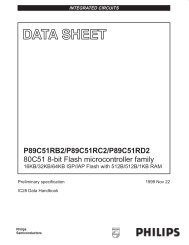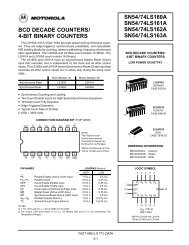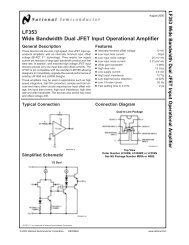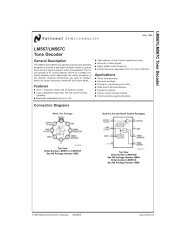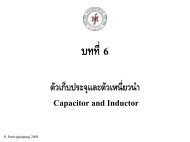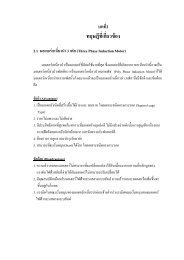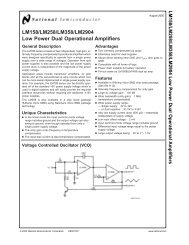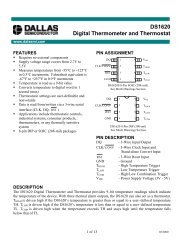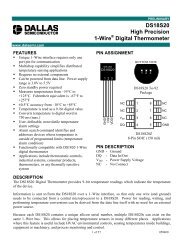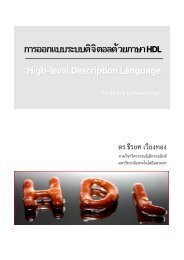Create successful ePaper yourself
Turn your PDF publications into a flip-book with our unique Google optimized e-Paper software.
3 of 8<strong>DS275</strong>volts, and in many situations it can be tied directly to the +5 volt VCC supply. It is important to note thatVDRV must be greater than or equal to VCC at all times.The voltage range on VDRV permits the use of a 9-volt battery in order to provide a higher voltage levelwhen TXOUT is in a space state. When VCC is shut off to the <strong>DS275</strong> and VDRV is still powered (as mighthappen in a battery-backed condition), only a small leakage current (about 50-100 nA) will be drawn. IfTXOUT is loaded during such a condition, VDRV will draw current only if RXIN is not in a negative state.During normal operation (VCC=5 volts), VDRV will draw less than 2 uA when TXOUT is marking. Ofcourse, when TXOUT is spacing, VDRV will draw substantially more current⎯=about 3 mA, dependingupon its voltage and the impedance that TXOUT sees.The TXOUT output is slew rate-limited to less than 30 volts/us in accordance with <strong>RS</strong>-<strong>232</strong> specifications.In the event TXOUT should be inadvertently shorted to ground, internal current-limiting circuitry preventsdamage, even if continuously shorted.<strong>RS</strong>-<strong>232</strong> COMPATIBILITYThe intent of the <strong>DS275</strong> is not so much to meet all the requirements of the <strong>RS</strong>-<strong>232</strong> specification as tooffer a low-power solution that will work with most <strong>RS</strong>-<strong>232</strong> ports with a connector length of less than 10feet. As a prime example, the <strong>DS275</strong> will not meet the <strong>RS</strong>-<strong>232</strong> requirement that the signal levels be atleast ±5 volts minimum when terminated by a 3 kΩ=load and VDRV = +5 volts. Typically a voltage of 4volts will be present at TXOUT when spacing. However, since most <strong>RS</strong>-<strong>232</strong> receivers will correctlyinterpret any voltage over 2 volts as a space, there will be no problem transmitting data.APPLICATIONS INFORMATIONThe <strong>DS275</strong> is designed as a low-cost, <strong>RS</strong>-<strong>232</strong>-E interface expressly tailored for the unique requirementsof battery-operated handheld products. As shown in the electrical specifications, the <strong>DS275</strong> drawsexceptionally low operating and static current. During normal operation when data from the handheldsystem is sent from the TXOUT output, the <strong>DS275</strong> only draws significant VDRV current when TXOUTtransitions positively (spacing). This current flows primarily into the <strong>RS</strong>-<strong>232</strong> receiver’s 3-7 kΩ=load at theother end of the attaching cable. When TXOUT is marking (a negative data signal), the VDRV current fallsdramatically since the negative voltage is provided by the transmit signal from the other end of the cable.This represents a large reduction in overall operating current, since typical <strong>RS</strong>-<strong>232</strong> interface chips usecharge-pump circuits to establish both positive and negative levels at the transmit driver output.To obtain the lowest power consumption from the <strong>DS275</strong>, observe the following guidelines. First, tominimize VDRV current when connected to an <strong>RS</strong>-<strong>232</strong> port, always maintain TXIN at a logic 1 when data isnot being transmitted (idle state). This will force TXOUT into the marking state, minimizing VDRV current.Second, VDRV current will drop to less than 100 nA when VCC is grounded. Therefore, if VDRV is tieddirectly to the system battery, the logic +5 volts can be turned off to achieve the lowest possible powerstate.FULL-DUPLEX OPERATIONThe <strong>DS275</strong> is intended primarily for half-duplex operation; that is, RXIN should remain idle in themarking state when transmitting data out TXOUT and visa versa. However, the part can be operated fullduplexwith most <strong>RS</strong>-<strong>232</strong>-E serial ports since signals swinging between 0 and +5V will usually becorrectly interpreted by an <strong>RS</strong>-<strong>232</strong>-E receiver device. The 5-volt swing occurs when TXOUT attempts toswing negative while RXIN is at a positive voltage, which turns on an internal weak pulldown to groundfor the TXOUT driver’s negative reference. So, transmit mark signals at TXOUT may have voltage jumpsfrom some negative value (corresponding to RXIN marking) to approximately ground. One possible



